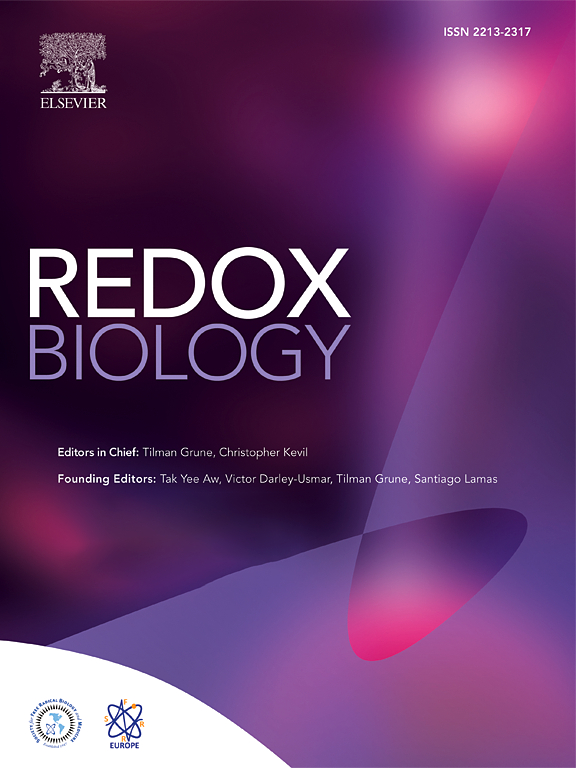Supplement-driven iron overload accelerates phenotypic aging via inflammatory biomarkers: Potential counteraction through anti-inflammatory or antioxidant diets
IF 10.7
1区 生物学
Q1 BIOCHEMISTRY & MOLECULAR BIOLOGY
引用次数: 0
Abstract
Given the dual effects of iron on health, we carried out this study to explore its relationship with phenotypic age (PhenoAge) and to evaluate the roles of inflammation and oxidative stress in this regard. Since these associations are still poorly understood, elucidating them is vital for understanding aging-related health outcomes. A cross-sectional study was conducted using NHANES 2017–2018 data, involving 8692 participants aged 20 years or older. The nonlinear relationships between iron intake and PhenoAge acceleration (PhenoAgeAccel) were assessed using weighted restricted cubic splines (RCS). Multivariable-adjusted analyses were performed using weighted generalized linear models (GLMs). K-means clustering was employed to identify patterns of iron co-exposure. Interaction effects were assessed using likelihood ratio tests, while mediation analyses were conducted to quantify the contributions of inflammation and oxidative stress markers. This study identified a U-shaped relationship between total iron intake and PhenoAgeAccel (breakpoint: 18.441 mg/day). Below this threshold, higher iron intake was protective against aging (β = −0.126); above it, aging accelerated (β = 0.021). Notably, dietary iron derived solely from food was not associated with any harmful effects on aging. In contrast, supplemental iron intake showed a positive association with PhenoAgeAccel (β = 0.017), highlighting the potential risks of excessive supplement use. Moreover, the aforementioned associations showed no gender differences. Cluster analysis split participants into two groups: dietary iron reference (DIR), mostly below the UL (45 mg/day) with minimal supplemental iron; and supplement-driven iron overload (SDIO), all exceeding the UL, with supplemental iron comprising 83.44 % of total intake on average. SDIO showed significantly faster phenotypic aging (β = 1.774) than DIR. However, anti-inflammatory or antioxidant diets were able to counteract this detrimental effect (P for interaction = 0.025). Inflammation-related markers partially mediated SDIO-associated aging acceleration (mediation proportion: 15.53 %–25.63 %). The results stayed robust even after adjusting for variables related to anemia and post-menstrual status. This study suggests that excessive use of supplements, resulting in iron overload, may accelerate individual aging through inflammation-related pathways. Nevertheless, a diet abundant in anti-inflammatory or antioxidant properties could counteract this heightened risk of aging.
补充剂驱动的铁过载通过炎症生物标志物加速表型衰老:通过抗炎或抗氧化饮食的潜在抵消作用
鉴于铁对健康的双重影响,我们开展了这项研究,以探索其与表型年龄(PhenoAge)的关系,并评估炎症和氧化应激在这方面的作用。由于这些关联仍然知之甚少,阐明它们对于理解与衰老相关的健康结果至关重要。使用NHANES 2017-2018年的数据进行了一项横断面研究,涉及8,692名20岁或以上的参与者。采用加权限制三次样条(RCS)评估铁摄入量与表型加速(PhenoAgeAccel)之间的非线性关系。采用加权广义线性模型(GLMs)进行多变量调整分析。采用k均值聚类来确定铁共暴露的模式。使用似然比检验评估相互作用效应,同时进行中介分析以量化炎症和氧化应激标志物的贡献。该研究确定了总铁摄入量与PhenoAgeAccel之间的u型关系(断点:18.441 mg/天)。低于这个阈值,高铁摄入量对衰老有保护作用(β = -0.126);在此基础上,老化加速(β = 0.021)。值得注意的是,仅从食物中获取的膳食铁与衰老没有任何有害影响。相反,补充铁摄入量与PhenoAgeAccel呈正相关(β = 0.017),突出了过量补充铁的潜在风险。此外,上述联想并无性别差异。聚类分析将参与者分为两组:膳食铁参考(DIR),大多数低于UL(45毫克/天),补充铁最少;和补充剂驱动的铁过载(SDIO),均超过UL,补充铁平均占总摄入量的83.44%。SDIO表型衰老明显快于DIR (β = 1.774)。然而,抗炎或抗氧化饮食能够抵消这种有害影响(相互作用P = 0.025)。炎症相关标志物部分介导sdio相关的衰老加速(介导比例:15.53% ~ 25.63%)。即使在调整了与贫血和月经后状态相关的变量后,结果仍然很明显。这项研究表明,过量服用补品,导致铁超载,可能会通过炎症相关途径加速个体衰老。然而,富含抗炎或抗氧化特性的饮食可以抵消这种增加的衰老风险。
本文章由计算机程序翻译,如有差异,请以英文原文为准。
求助全文
约1分钟内获得全文
求助全文
来源期刊

Redox Biology
BIOCHEMISTRY & MOLECULAR BIOLOGY-
CiteScore
19.90
自引率
3.50%
发文量
318
审稿时长
25 days
期刊介绍:
Redox Biology is the official journal of the Society for Redox Biology and Medicine and the Society for Free Radical Research-Europe. It is also affiliated with the International Society for Free Radical Research (SFRRI). This journal serves as a platform for publishing pioneering research, innovative methods, and comprehensive review articles in the field of redox biology, encompassing both health and disease.
Redox Biology welcomes various forms of contributions, including research articles (short or full communications), methods, mini-reviews, and commentaries. Through its diverse range of published content, Redox Biology aims to foster advancements and insights in the understanding of redox biology and its implications.
 求助内容:
求助内容: 应助结果提醒方式:
应助结果提醒方式:


